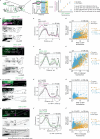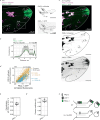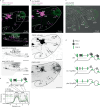Polycystins recruit cargo to distinct ciliary extracellular vesicle subtypes in C. elegans
- PMID: 40180912
- PMCID: PMC11968823
- DOI: 10.1038/s41467-025-57512-3
Polycystins recruit cargo to distinct ciliary extracellular vesicle subtypes in C. elegans
Abstract
Therapeutic use of tiny extracellular vesicles (EVs) requires understanding cargo loading mechanisms. Here, we use a modular proximity labeling approach to identify the cargo of ciliary EVs associated with the transient receptor potential channel polycystin-2 PKD-2 of C. elegans. Polycystins are conserved ciliary proteins and cargo of EVs; dysfunction causes polycystic kidney disease in humans and mating deficits in C. elegans. We discover that polycystins localize with specific cargo on ciliary EVs: polycystin-associated channel-like protein PACL-1, dorsal and ventral polycystin-associated membrane C-type lectins PAMLs, and conserved tumor necrosis factor receptor-associated factor (TRAF) TRF-1 and TRF-2. Loading of these components to EVs relies on polycystin-1 LOV-1. Our modular EV-TurboID approach can be applied in both cell- and tissue-specific manners to define the composition of distinct EV subtypes, addressing a major challenge of the EV field.
© 2025. The Author(s).
Conflict of interest statement
Competing interests: The authors declare no competing interests.
Figures








Update of
-
Polycystins recruit cargo to distinct ciliary extracellular vesicle subtypes.bioRxiv [Preprint]. 2024 Apr 18:2024.04.17.588758. doi: 10.1101/2024.04.17.588758. bioRxiv. 2024. Update in: Nat Commun. 2025 Apr 03;16(1):2899. doi: 10.1038/s41467-025-57512-3. PMID: 38659811 Free PMC article. Updated. Preprint.
References
MeSH terms
Substances
Grants and funding
- R24 OD010943/OD/NIH HHS/United States
- K12 GM093854/GM/NIGMS NIH HHS/United States
- P40 OD010440/OD/NIH HHS/United States
- R01 DK059418/DK/NIDDK NIH HHS/United States
- R01 DK116606/DK/NIDDK NIH HHS/United States
- R01 NS120745/NS/NINDS NIH HHS/United States
- DK059418/U.S. Department of Health & Human Services | NIH | National Institute of Diabetes and Digestive and Kidney Diseases (National Institute of Diabetes & Digestive & Kidney Diseases)
- RF1 NS120745/NS/NINDS NIH HHS/United States
- NS120745/U.S. Department of Health & Human Services | NIH | National Institute of Neurological Disorders and Stroke (NINDS)
- GM093854/U.S. Department of Health & Human Services | NIH | National Institute of General Medical Sciences (NIGMS)
- S10 OD016400/OD/NIH HHS/United States
- S10 OD025140/OD/NIH HHS/United States
- DK116606/U.S. Department of Health & Human Services | NIH | National Institute of Diabetes and Digestive and Kidney Diseases (National Institute of Diabetes & Digestive & Kidney Diseases)
LinkOut - more resources
Full Text Sources
Research Materials
Miscellaneous

